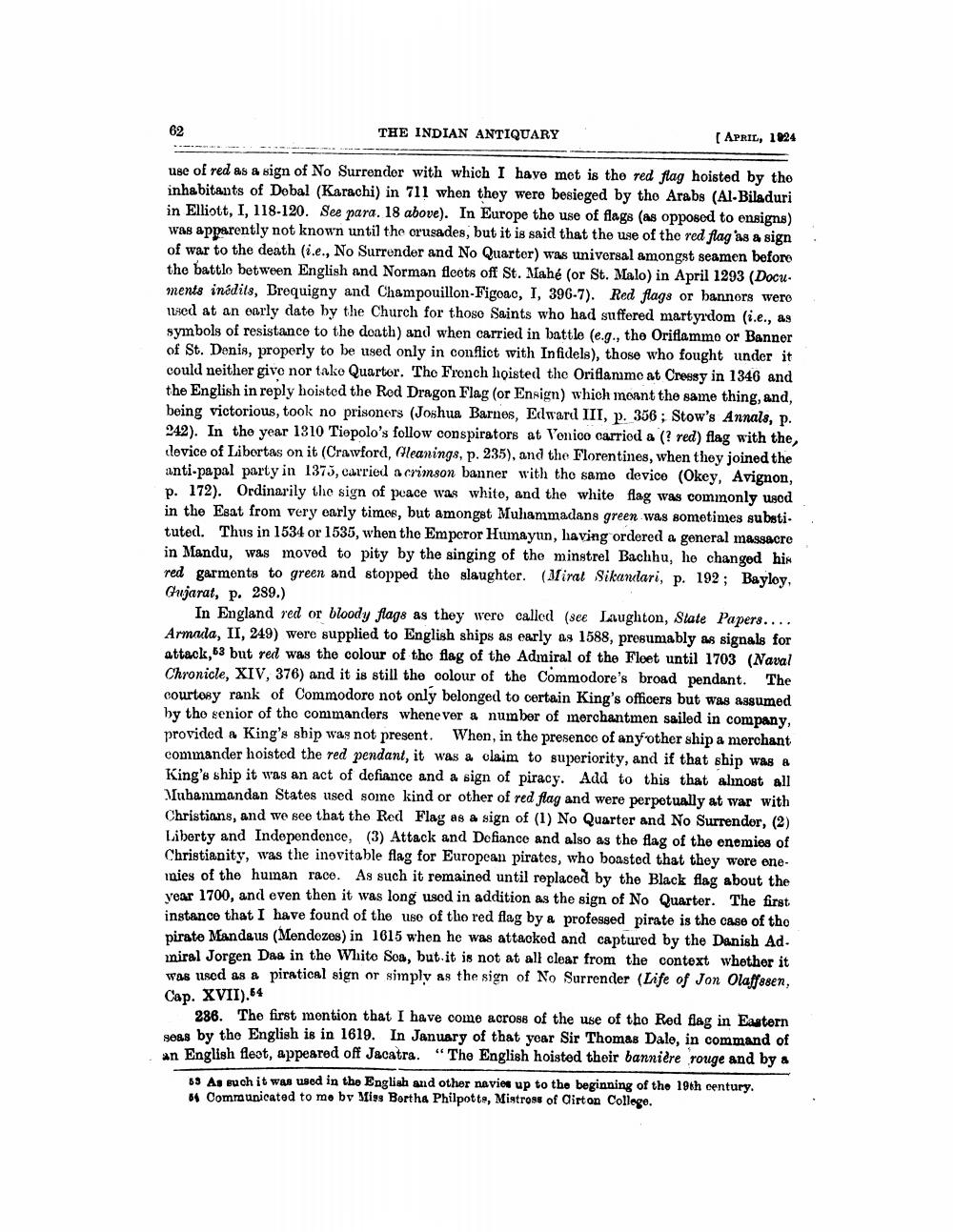________________
62
THE INDIAN ANTIQUARY
[APRIL, 1924
use of red as a sign of No Surrender with which I have met is the red flag hoisted by the inhabitants of Debal (Karachi) in 711 when they were besieged by the Arabs (Al-Biladuri in Elliott, I, 118-120. See para. 18 above). In Europe the use of flags (as opposed to ensigns) was apparently not known until the crusades, but it is said that the use of the red flag as a sign of war to the death (i.e., No Surrender and No Quarter) was universal amongst seamen before the battle between English and Norman fleets off St. Mahé (or St. Malo) in April 1293 (Documents inédits, Brequigny and Champouillon-Figeac, I, 396-7). Red flags or banners were used at an early date by the Church for those Saints who had suffered martyrdom (i.e., as symbols of resistance to the death) and when carried in battle (e.g., the Oriflamme or Banner of St. Denis, properly to be used only in conflict with Infidels), those who fought under it could neither give nor take Quarter. The French hoisted the Oriflamme at Cressy in 1346 and the English in reply hoisted the Red Dragon Flag (or Ensign) which meant the same thing, and, being victorious, took no prisoners (Joshua Barnes, Edward III, p. 356; Stow's Annals, p. 242). In the year 1310 Tiepolo's follow conspirators at Venico carried a (? red) flag with the, device of Libertas on it (Crawford, Gleanings, p. 235), and the Florentines, when they joined the anti-papal party in 1375, carried a crimson banner with the same device (Okey, Avignon, p. 172). Ordinarily the sign of peace was white, and the white flag was commonly used in the Esat from very early times, but amongst Muhammadans green was sometimes substi tuted. Thus in 1534 or 1535, when the Emperor Humayun, having ordered a general massacre in Mandu, was moved to pity by the singing of the minstrel Bachhu, he changed his red garments to green and stopped the slaughter. (Miral Sikandari, p. 192; Bayley, Gujarat, p. 289.)
In England red or bloody flags as they were called (see Laughton, State Papers.... Armada, II, 249) were supplied to English ships as early as 1588, presumably as signals for attack,63 but red was the colour of the flag of the Admiral of the Fleet until 1703 (Naval Chronicle, XIV, 376) and it is still the colour of the Commodore's broad pendant. The courtesy rank of Commodore not only belonged to certain King's officers but was assumed by the senior of the commanders whenever a number of merchantmen sailed in company, provided a King's ship was not present. When, in the presence of any other ship a merchant commander hoisted the red pendant, it was a claim to superiority, and if that ship was a King's ship it was an act of defiance and a sign of piracy. Add to this that almost all Muhammandan States used some kind or other of red flag and were perpetually at war with Christians, and we see that the Red Flag as a sign of (1) No Quarter and No Surrender, (2) Liberty and Independence, (3) Attack and Defiance and also as the flag of the enemies of Christianity, was the inevitable flag for European pirates, who boasted that they were onenies of the human race. As such it remained until replaced by the Black flag about the year 1700, and even then it was long used in addition as the sign of No Quarter. The first instance that I have found of the use of the red flag by a professed pirate is the case of the pirate Mandaus (Mendezes) in 1615 when he was attacked and captured by the Danish Ad. miral Jorgen Daas in the White Sea, but it is not at all clear from the context whether it was used as a piratical sign or simply as the sign of No Surrender (Life of Jon Olaffssen, Cap. XVII),
286. The first mention that I have come across of the use of tho Red flag in Eastern seas by the English is in 1619. In January of that year Sir Thomas Dale, in command of an English fleet, appeared off Jacatra. "The English hoisted their bannière rouge and by a
53 As such it was used in the English and other navies up to the beginning of the 19th century. 54 Communicated to me by Miss Bertha Philpotts, Mistress of Cirton College.




